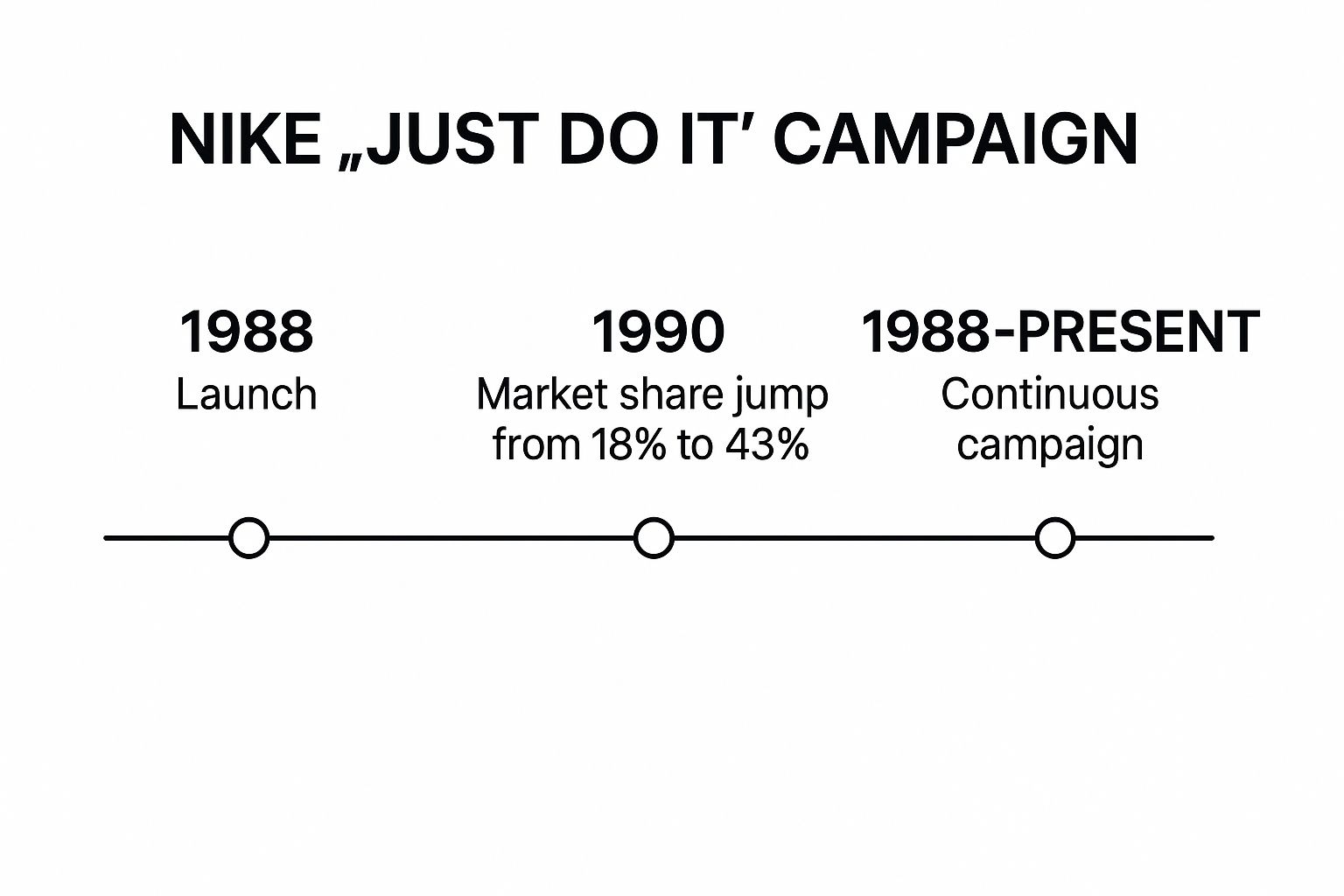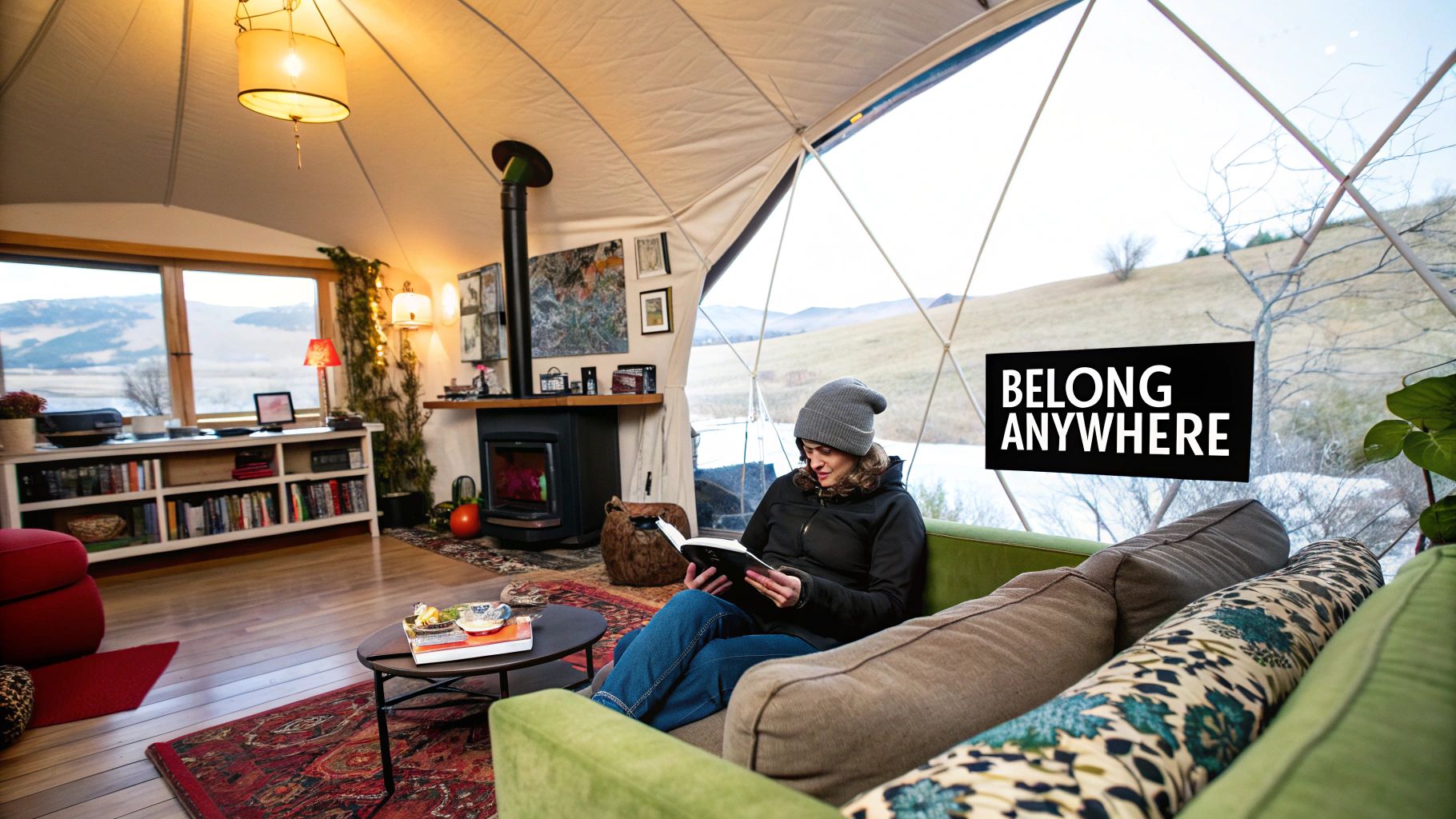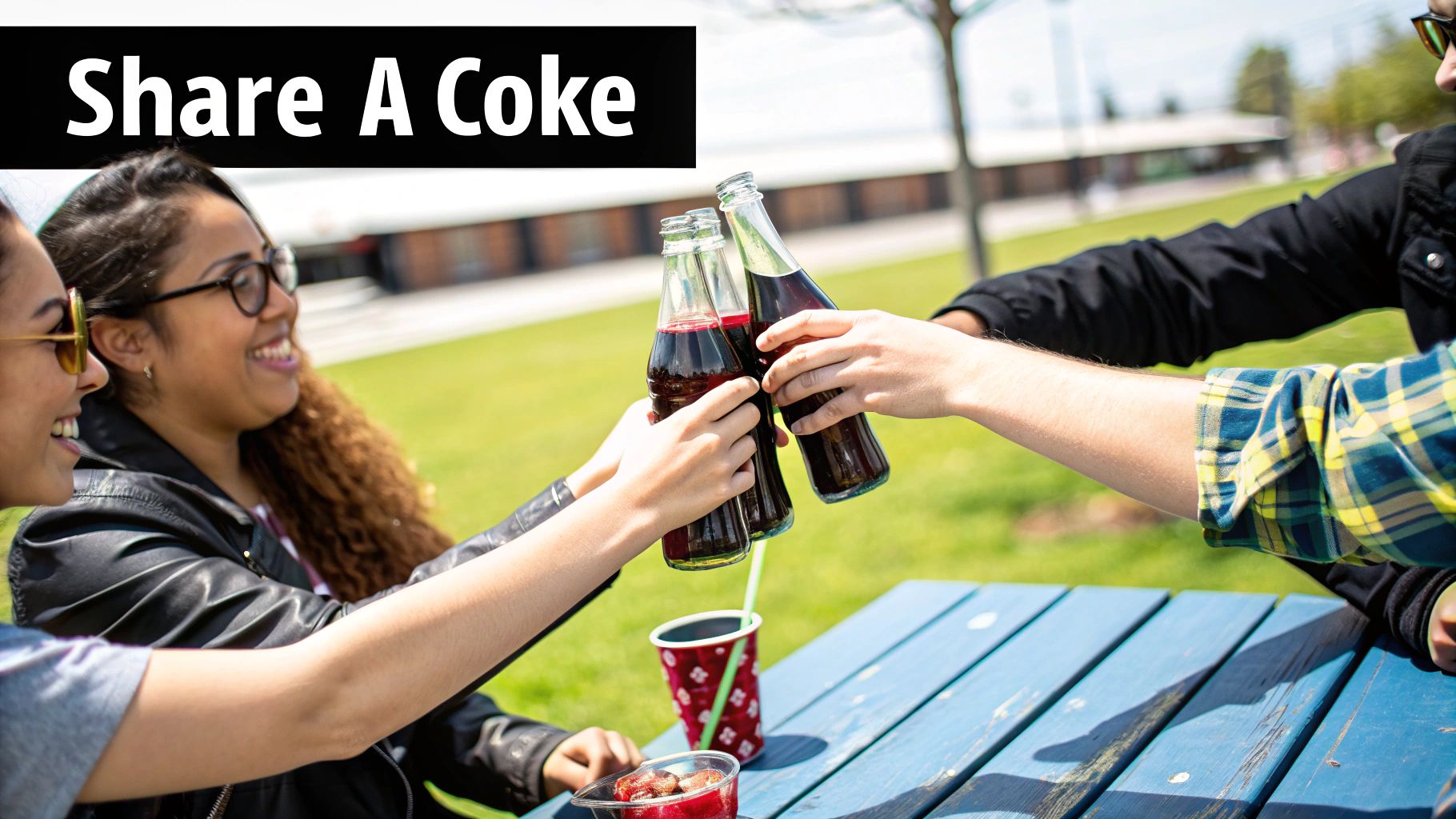
Top Brand Storytelling Examples to Inspire in 2025
Discover inspiring brand storytelling examples that can elevate your strategy in 2025. Explore compelling cases and boost your brand's impact.
In today's crowded market, features and benefits alone don't build loyalty. The most resonant brands connect on a human level, transforming customers into advocates through powerful narratives. Brand storytelling isn't just about marketing; it's about forging an emotional bond that turns a simple product into a part of someone's identity. This foundational concept is rooted in the importance of telling people why your product matters over focusing solely on features, which is the key to authentic connection.
This article dives deep into seven phenomenal brand storytelling examples, dissecting the exact strategies that made them iconic. We move beyond surface-level praise to provide a tactical breakdown of what works and why. You will learn how global giants like Nike and innovative platforms like Airbnb use distinct narrative frameworks to build unshakable brand affinity.
We will explore the specific campaigns from brands like Dove, Apple, and Patagonia, analyzing their execution and results. Each example includes a strategic analysis and actionable takeaways designed for marketers, entrepreneurs, and content creators. Get ready to learn the replicable methods you can use to craft a compelling story, turning your brand’s message into a memorable and profitable experience.
1. Nike - Just Do It Campaign
Nike's "Just Do It" campaign, launched in 1988, is one of the most enduring and powerful brand storytelling examples in advertising history. It transcended product marketing by focusing not on sneakers, but on the raw, universal human emotions of determination, struggle, and triumph. This approach transforms a simple slogan into a deeply resonant brand philosophy.
The Strategy: From Product to Persona
The core strategy, developed by the Wieden+Kennedy agency, was to create an emotional connection by telling stories of overcoming adversity. Instead of showcasing product features, Nike highlighted the internal battles and external obstacles faced by athletes and everyday people. The brand became a symbol of the mindset required to push past limits, making it a source of inspiration rather than just a supplier of gear.
A key takeaway is that Nike sells a feeling, an identity. The story is never "buy these shoes to run faster." It is "you have the strength to overcome this, and we are with you." This shift from a transactional to an aspirational message builds immense brand loyalty.
Execution and Impact
The campaign's genius lies in its consistency and adaptability. It has featured iconic athletes like Serena Williams and Michael Jordan, but also lesser-known figures and everyday heroes whose struggles are relatable. The "Dream Crazy" ad featuring Colin Kaepernick demonstrated Nike's willingness to embrace controversial, yet authentic, narratives that align with its core message of courage.
This timeline illustrates the campaign's immediate and long-term success.

The infographic highlights how the campaign quickly translated into massive market share growth, proving the commercial power of authentic storytelling.
Actionable Takeaways for Marketers
- Focus on the Human Experience: Center your narrative on universal emotions and struggles rather than product specs.
- Maintain a Consistent Voice: Whether featuring a global icon or a local athlete, the core message of determination should remain unwavering.
- Invest in High-Quality Visuals: Use powerful imagery and cinematography to evoke emotion and tell a compelling story.
- Connect to a Universal Theme: Ground individual stories in a broader, relatable theme like overcoming fear, achieving a dream, or fighting for a belief. The success of this approach is often rooted in a well-defined strategy, and you can learn more about developing one with this marketing campaign planning template.
2. Airbnb - Belong Anywhere
Airbnb shifted the travel industry's narrative from transactional bookings to authentic human experiences with its "Belong Anywhere" philosophy. This campaign is a masterclass in brand storytelling that positions the company not as a lodging provider, but as a facilitator of connection, community, and cultural immersion. The core of this story is that travel is about finding a sense of home, no matter where you are in the world.

The Strategy: From Accommodation to Community
Airbnb's strategy was to empower its users, both hosts and guests, to become the primary storytellers. Instead of creating fictional brand narratives, the company built a platform that curates and amplifies real-life stories of connection. The brand story is crowdsourced, focusing on the unique homes, welcoming hosts, and transformative experiences that define the Airbnb community. This makes the brand feel authentic and trustworthy.
A key takeaway is that Airbnb sells belonging, not just a place to stay. The narrative isn't "book a cheaper room," but "live like a local and connect with new people." This user-generated approach fosters a powerful sense of ownership and community among its users.
Execution and Impact
The "Belong Anywhere" message has been consistently executed across all marketing channels. Airbnb spotlights host stories, shares guest travelogues, and even extends its brand purpose into social good with initiatives like its disaster relief housing program. During the Olympic Games, their stories focused on hosts opening their homes to global visitors, reinforcing the theme of international community.
This focus on authentic human stories, rather than just picturesque locations, has built a brand that resonates on a deeply emotional level. It has allowed Airbnb to differentiate itself in a crowded market by focusing on what truly matters in travel: the people you meet and the connections you make.
Actionable Takeaways for Marketers
- Empower Your Community: Create platforms and tools that allow your customers to share their own stories, turning them into brand advocates.
- Curate, Don't Fabricate: Leverage user-generated content to tell your brand's story. Your role is to find and amplify the most compelling authentic narratives.
- Connect to a Larger Purpose: Frame individual stories within a broader brand mission, such as building community or fostering connection.
- Build an Authentic Social Presence: Let real user experiences drive your social media content. You can explore how this fits into a larger strategy by developing a cohesive content strategy for social media marketing.
3. Dove - Real Beauty Campaign
Dove’s "Real Beauty" campaign, launched in 2004, is a landmark example of purpose-driven brand storytelling that challenged decades of industry norms. By shifting the conversation from aspirational, model-defined beauty to the celebration of real women, Dove created a powerful narrative centered on self-esteem and authenticity. This approach repositioned Dove as a champion for women, not just a seller of soap.
The Strategy: From Product to Purpose
The campaign's strategy, developed with Ogilvy & Mather, was rooted in extensive global research that revealed only 2% of women considered themselves beautiful. Dove decided to address this insight directly, creating a story that wasn't about its products but about the societal definition of beauty itself. The brand became a facilitator of a global conversation, empowering women to see and define their own beauty.
The core takeaway is that Dove built a movement, not just a campaign. The story is never "use this product to look like a model." It is "you are beautiful as you are, and society's narrow definition is wrong." This pivot from a product-centric to a purpose-driven message fosters deep emotional connection and brand advocacy.
Execution and Impact
The campaign's strength lies in its long-term commitment and multi-channel execution. It began with ads featuring real women of diverse ages, sizes, and ethnicities, a stark contrast to the industry standard. This evolved into highly emotional content like the "Real Beauty Sketches" viral video, which demonstrated the gap between how women see themselves and how others see them.
Further initiatives like the Dove Self-Esteem Project and its support for The CROWN Act (to end hair discrimination) have solidified the brand's commitment. By consistently telling stories that uplift and empower, Dove has demonstrated the incredible power of authentic, mission-based brand storytelling examples that resonate on a global scale.
Actionable Takeaways for Marketers
- Ground Storytelling in Genuine Research: Use real data and human insights to build a narrative that is authentic and relevant.
- Feature Authentic Voices: Move beyond actors and models to feature real people whose experiences align with your brand's mission.
- Commit for the Long Term: A purpose-driven story isn't a one-off campaign; it requires sustained commitment across all brand touchpoints.
- Be Prepared for Conversation: Tackling a meaningful social issue will invite both praise and criticism. Be ready to engage in the dialogue you start. Learn more about how to engage with your audience by crafting a strong social media content strategy.
4. Apple - Think Different
Apple's "Think Different" campaign, launched in 1997, is a masterclass in brand storytelling that redefined the company's identity. Instead of focusing on computer specs, Apple told a powerful story about the rebels, visionaries, and "crazy ones" who change the world. This narrative masterfully aligned the brand with creativity, non-conformity, and genius, transforming Apple from a struggling tech company into a cultural icon.
The Strategy: From Product to Philosophy
The strategy, spearheaded by Steve Jobs upon his return to Apple and executed by agency TBWA\Chiat\Day, was to create an emotional movement. The campaign celebrated historical figures like Albert Einstein, Martin Luther King Jr., and Mahatma Gandhi, individuals who challenged the status quo. By associating Apple products with these titans of innovation, the brand itself became a symbol of creative potential and independent thought.
The core insight was that Apple wasn't just selling computers; it was selling a tool for people who wanted to change the world. The story became, "We make tools for the creative minds, the misfits, the people who see things differently." This transformed customers into members of an exclusive, forward-thinking tribe.
Execution and Impact
The campaign's centerpiece was the iconic "The Crazy Ones" television commercial, narrated by Richard Dreyfuss, which never showed a single product. It was pure, distilled brand philosophy. This ethos extended to every touchpoint, from the minimalist product design to the unique retail store experience, all reinforcing the narrative of simplicity, elegance, and innovation.
This consistent storytelling helped orchestrate one of the greatest corporate turnarounds in history. It rebuilt customer loyalty, attracted a new generation of creative professionals, and laid the groundwork for the unprecedented success of products like the iMac, iPod, and iPhone.
Actionable Takeaways for Marketers
- Align with a Value System: Connect your brand to a core belief or value that resonates deeply with your target audience.
- Celebrate Your Audience: Make your customers the heroes of the story. Apple celebrated "the crazy ones," positioning its users as the true innovators.
- Maintain Narrative Consistency: Ensure every aspect of your brand, from product design to customer service, reinforces your core story.
- Invest in Premium Brand Experiences: Create high-quality touchpoints, like Apple's launch events and retail stores, that serve as chapters in your ongoing brand narrative.
5. Patagonia - Environmental Activism Stories
Patagonia has masterfully woven its mission-driven ethos into its brand identity, making its environmental activism one of the most authentic brand storytelling examples today. Instead of leading with products, Patagonia leads with its purpose: to save our home planet. This approach transforms customers into advocates, building a fiercely loyal community united by shared values.
The Strategy: From Commerce to Cause
Patagonia’s core strategy is to subordinate product marketing to its environmental mission. Founded by Yvon Chouinard, an activist at heart, the company has always used its platform to tell stories about conservation, sustainability, and conscious consumption. Campaigns like "Don't Buy This Jacket" and the "Worn Wear" program directly challenge consumerism, positioning Patagonia as a partner in sustainability rather than just a retailer.
The key takeaway is that Patagonia's brand story isn't a marketing tactic; it's the company's operational blueprint. The story is never "buy our gear to look like an adventurer." It is "join us in protecting the wild places we love, and here is the responsible gear you'll need." This values-first narrative fosters a deep, trust-based relationship with its audience.
Execution and Impact
Patagonia's execution is multi-faceted and consistently reinforces its core message. The company produces high-quality documentary films like "180° South," which celebrate adventure while highlighting environmental threats. Its "Footprint Chronicles" initiative provided radical transparency into its supply chain, building credibility. Furthermore, its commitment to donating 1% of sales to environmental causes (a pledge that helped launch the 1% for the Planet movement) proves its dedication is not just talk.
This unwavering commitment to its mission has built a brand that thrives on anti-consumerist messaging, a paradox that demonstrates the immense power of authentic, purpose-driven storytelling.
Actionable Takeaways for Marketers
- Lead with Your "Why": Build your brand narrative around a core mission or value system that transcends your products or services.
- Prove, Don't Just Proclaim: Back up your story with tangible actions, like transparent reporting, corporate initiatives, or financial commitments.
- Educate and Inspire Action: Use content to inform your audience about issues you care about and give them clear ways to get involved.
- Build a Community Around Values: Foster a sense of belonging by connecting customers through shared beliefs, turning them from passive buyers into active brand participants. Learn more about their approach and mission directly on the Patagonia website.
6. Coca-Cola - Share a Coke Personalization
Coca-Cola's 'Share a Coke' campaign, first launched in Australia in 2011, masterfully transformed a mass-produced product into a deeply personal storytelling device. By replacing its iconic logo with hundreds of popular first names, the campaign invited consumers to find their own name or the name of someone they cared about, creating millions of individual, shareable moments. This initiative brilliantly blended physical products with digital engagement, revitalizing the brand's connection with a younger audience.

The Strategy: From Mass Brand to Personal Invitation
The core strategy, developed with Ogilvy Sydney, was to shift the narrative from Coca-Cola's story to the consumer's story. Instead of broadcasting a single message, the brand provided a prompt: "Share a Coke with [Name]." This simple change empowered customers to become the storytellers, turning the act of buying a soda into a personal gesture of connection, friendship, or love.
The key takeaway is that the brand stepped back and made the customer the hero. The story wasn't "buy our drink," but rather "here's a reason to connect with someone you know." This participatory approach generated authentic, user-driven content at a massive scale.
Execution and Impact
The campaign's execution was a masterclass in hyper-personalization and cultural adaptation. It began with 150 of Australia’s most common names and quickly expanded globally, adapting name lists and even including generic terms like "Mom," "Dad," and "Bestie" to broaden its appeal. Coca-Cola also set up interactive kiosks allowing people to print custom bottles, creating unique touchpoints that drove excitement and social sharing.
The campaign was a monumental success, reversing a decade of declining consumption among young adults in the U.S. and boosting sales significantly worldwide. It stands as one of the most effective brand storytelling examples of the digital age.
Actionable Takeaways for Marketers
- Make Your Customer the Protagonist: Design campaigns that allow consumers to see themselves and their relationships within your brand's narrative.
- Bridge the Physical and Digital: Use physical product packaging as a trigger for digital engagement and social sharing.
- Leverage the Power of Personalization: Even simple personalization, like using a first name, can create a powerful emotional connection.
- Think Globally, Act Locally: Adapt your core concept to fit the cultural nuances, languages, and even popular names of different markets to ensure relevance.
7. Spotify - Year in Music/Wrapped Data Storytelling
Spotify’s annual “Wrapped” campaign is a masterful example of data-driven brand storytelling that transforms user statistics into a highly personal and shareable cultural event. Rather than broadcasting a universal brand message, Spotify turns the spotlight on its users, celebrating their individual listening habits and making each person the hero of their own musical journey. This creates a deeply engaging experience that feels unique and celebratory.
The Strategy: From Data to Personal Narrative
The core strategy behind Wrapped is to convert raw, impersonal data points into a compelling personal narrative. Instead of simply presenting numbers, Spotify frames them as chapters in a user's year: top artists, most-played songs, and newly discovered genres. The brand becomes a reflective tool, showing users a part of their own identity through the music they consumed.
A key takeaway is that Spotify makes its platform indispensable by making its data personal. The story isn't "see how much you used our service," but "here is the soundtrack of your year, a reflection of who you were." This transforms a utility into a personal archivist, fostering an emotional bond and viral engagement.
Execution and Impact
The execution is what makes Wrapped an annual phenomenon. It leverages vibrant, dynamic visuals and a mobile-first user experience to present the data in a fun, story-like format. Features like "Audio Aura" and listening personality types add a layer of novel self-discovery, making the results highly shareable on social media. Each year, it generates millions of organic impressions as users eagerly post their personalized summaries.
This approach turns every user into a brand advocate. The campaign not only reinforces loyalty among existing users but also creates a massive wave of FOMO (fear of missing out), driving new subscriptions from people who want to participate the following year.
Actionable Takeaways for Marketers
- Turn Data into a Personal Story: Find ways to use customer data to reflect their own journey and identity back to them, making them the protagonist.
- Invest in Shareable Design: Create visually appealing, easily digestible formats (like stories or cards) that are optimized for social media sharing.
- Build Anticipation: Make the event a consistent, annual tradition that customers can look forward to.
- Prioritize Personalization: The more unique and tailored the story feels to the individual, the more emotionally resonant and shareable it becomes. Creating dynamic visual content is key, and businesses can learn more about how to get started with small business video marketing.
Brand Storytelling Comparison of 7 Campaigns
| Campaign | Implementation Complexity 🔄 | Resource Requirements ⚡ | Expected Outcomes 📊 | Ideal Use Cases 💡 | Key Advantages ⭐ | |---------------------------------|------------------------------------|-----------------------------------|---------------------------------------|-------------------------------------------------|----------------------------------------------------| | Nike - Just Do It Campaign | High – Requires premium storytelling and global coordination | High – Investment in quality visuals, athlete partnerships | Strong emotional connection; viral impact; premium brand positioning | Brands seeking lifestyle identity and emotional storytelling | Deep brand loyalty; viral social content; premium pricing | | Airbnb - Belong Anywhere | Moderate – Managing UGC and community curation | Moderate – Leverage user content, less centralized control | Trust building; authentic engagement; community growth | Platforms or brands focusing on community and authenticity | Cost-effective; authentic user stories; differentiation from traditional industry | | Dove - Real Beauty Campaign | Moderate to High – Social research and global adaptation | Moderate – Multi-channel educational content | Strong emotional connection; media buzz; brand loyalty | Brands addressing social issues and challenging norms | Socially conscious positioning; industry influence; emotional impact | | Apple - Think Different | High – Coordinated messaging and premium brand experiences | High – Investment in brand campaigns, events, and retail | Elevated brand perception; aspirational identity | Technology and innovation brands targeting creative professionals | Aspirational branding; loyal advocates; premium pricing support | | Patagonia - Environmental Stories| Moderate to High – Long-term activism and transparent practices | Moderate – Content creation and environmental initiatives | Authentic brand community; earned media; values-driven sales | Purpose-driven brands focused on sustainability and activism | Authenticity; passionate community; differentiation from mass market | | Coca-Cola - Share a Coke | High – Complex logistics for mass customization | High – Production complexity and social media integration | Increased sales; social engagement; brand revitalization | FMCG companies leveraging personalization and social sharing | Personal connection; social media virality; global adaptability | | Spotify - Year in Music/Wrapped | High – Data processing and personalized content generation | High – Technology and design investment | Massive social sharing; user engagement; platform showcase | Data-driven brands seeking personalized storytelling | Highly personalized content; annual engagement cycles; social reach |
Turn These Examples into Your Winning Strategy
The powerful brand storytelling examples we have dissected, from Nike's defiant spirit to Spotify's hyper-personalized data narratives, reveal a universal truth. The most resonant and enduring brands do not just sell products; they champion ideas, build communities, and invite customers to become part of a larger, more meaningful story. They prove that lasting connections are forged not through transactions, but through shared values and emotional resonance.
These campaigns, whether from giants like Apple or purpose-driven leaders like Patagonia, are not happy accidents. They are the result of a deliberate, strategic process that you can adapt for your own brand, regardless of its size or budget. The common thread is a deep commitment to authenticity and a relentless focus on the audience's core desires.
From Blueprint to Action: Your Storytelling Framework
To move from inspiration to implementation, you must first distill your brand’s core essence. Go beyond features and benefits and ask the fundamental questions: What is our "why"? What change do we want to create for our customers? Once you have this core truth, you can build a powerful narrative around it.
Here’s a simple, actionable framework based on the successes we've seen:
- Identify Your Hero: Your customer is always the protagonist. Their struggles, goals, and aspirations should be the central focus of your story.
- Define the Conflict: What is the real-world challenge or internal struggle your hero faces? Coca-Cola identified a lack of personal connection in a digital world; Dove confronted narrow, unrealistic beauty standards.
- Present the Resolution: Position your brand not as the hero, but as the mentor or the tool that empowers the hero to achieve their goal. Your product or service facilitates their transformation.
Weaving Your Narrative into the Digital Tapestry
Once your story is defined, the next step is bringing it to life. Each example demonstrates the power of choosing the right medium for the message. Spotify uses data to make each user feel seen, while Airbnb leverages user-generated content to build trust and community. The strategic lesson is to meet your audience where they are and speak their language.
Many of these narratives gain such momentum that they become cultural touchstones. To further grasp how powerful narratives drive widespread engagement, you can explore compelling viral marketing examples that show how a single, compelling story can capture the public's imagination. Mastering the art of brand storytelling is no longer a "nice-to-have"; it is a critical differentiator in a crowded marketplace. It is the most effective way to build brand equity, foster loyalty, and create something your audience not only buys from, but truly believes in. Use these examples as your guide, find your unique voice, and start telling the story only you can tell.
Ready to turn your brand story into compelling visual content that captivates your audience? With ViewPrinter, you can effortlessly generate high-quality, emotionally resonant videos and ads for platforms like TikTok and Instagram. Start creating stories that connect and convert today. Visit ViewPrinter to learn more.